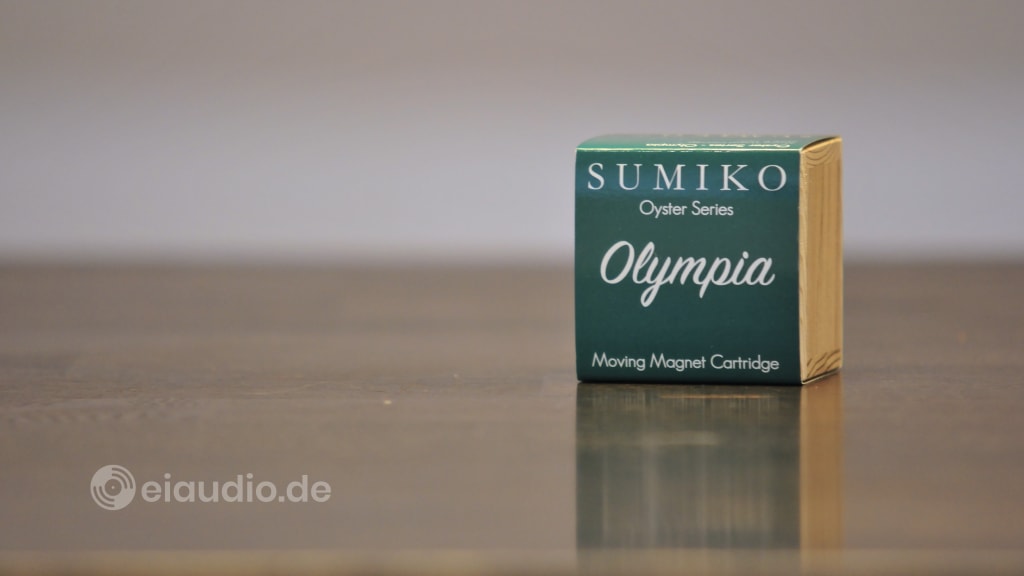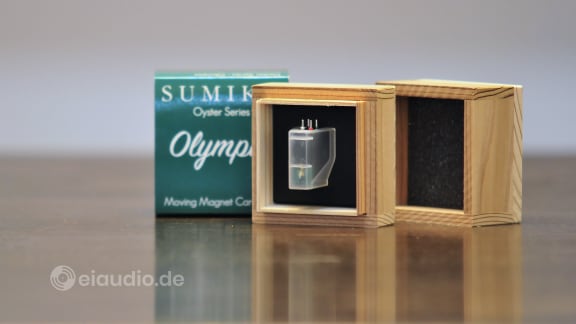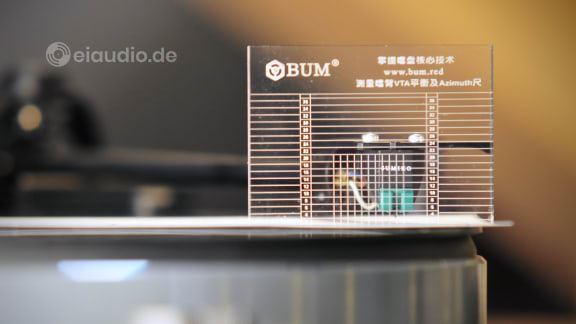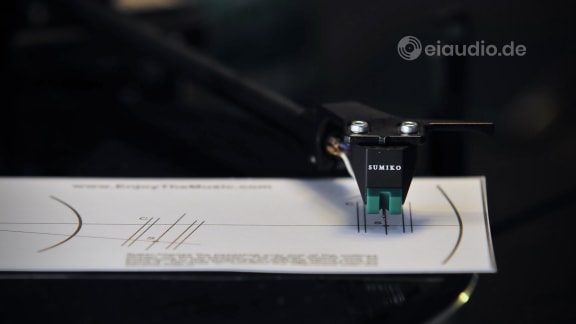Sumiko Olympia
Published: 22/02/2022
Manufacturing date: 2018
Author: Karsten Hein
Category: Gear & Review
Tag(s): Phono Cartridges
I stumbled upon the Sumiko range of phono cartridges while I was looking for a suitable pickup to complement our Thorens TD320 semi-automatic turntable. The TD320 came equipped with a TP16 MK IV tonearm, at a mass of 12.5 grams, which theoretically made it compatible with a wide selection of medium-compliance cartridges. Among the possible choices were MM (moving magnet) cartridges from Audio Technica, Grado, Ortofon, Nagaoka, and Sumiko. However, since I had already presented two Audio Technica cartridges in this blog and found the Grado Gold rather pricy, I narrowed it down to the Ortofon M2 Blue and the Sumiko Olympia, which ranked similarly in specs and performance.
In the end, my vote fell on the Olympia, as its dimensions and colour scheme worked well with the black and silver Thorens design. I had read that it sounded less analytical than the Ortofon, which I thought might compliment our fairly open sounding electrostatic speakers. My first impression when the cartridge arrived seemed to suggest that I had made a good decision. Taking it out of its wooden box was a lovely ritual that highlighted the company’s high-quality “handcrafted in Japan” mission statement. When mounted on the TP16, the sleek black body with clean white lettering looked absolutely stunning. I took special care to properly adjust all parameters, and the pictures below show part of this process before completion.
The first record I put on was Stacey Kent’s album “I Know I Dream” which happened to be of an acceptable pressing and worked quite well, until inner-groove sibilance increased on the final two tracks to such an extent that I was happy for the record to be over. Since I was still unfamiliar with the Thorens, I re-checked the VTA on the seamlessly adjustable shell and also tightened the vertical and horizontal tonearm bearings, thinking that this might be the cause of the problem. When this did not eliminate the sibilance, I played with the tracking and re-adjusted the platter level. However, no matter how hard I tried, the TP16 MK IV was unable to hold the Sumiko in place sufficiently to play without sibilance and inner-groove distortion. I called support at Thakker.eu to ask for advice, and they suggested that the Thorens’ arm might not be rigid enough for the Sumiko to perform well.
I ran some more tests with other settings and recordings and found that Katie Melua’s “Album No 8” was distorted from start to finish with the Sumiko, while it tracked well with both our Audio Technica cartridges equipped with micro-linear styli. I was feeling quite shattered at first, but then I decided to test the Sumiko on our Technics SL-1310 turntable in the other listening room. While inner-groove distortion remained an issue here, the Sumiko did produce a pleasant, super-wide, and solid soundstage that was so impressive, I could see myself having trouble returning the cartridge to the vendor without feeling regret.
I decided to check the stylus under a microscope and saw that the diamond was hidden under a thin cloak of residue that made the surface look grainy. I was familiar with this look from NOS styli made during the 70s. How could this be the case on the factory-fitted stylus of a brand new 2021 model cartridge, I wondered. Perhaps it was just a matter of wearing down the residue until the stylus’ diamond could once again shine through? I was starting to feel some regret that my records would have to go through this unhealthy treatment. Perhaps ambient moisture or seawater had played a role in corroding the stylus? After all, I had read somewhere that Sumiko cartridges were made in a town located close to the sea. This was confirmed on the company website.
Sumiko Company History
Sumiko was co-founded by former U.C. Berkeley experimental physicist David Fletcher in 1972. Fletcher made a name for himself in analogue music design and later went on to become the co-founder of SOTA turntables, another well-known brand that is still in business today. During the 1970s and 80s, Sumiko grew to be a leading importer of cartridges and tonearms of various brands to the USA. Some of Sumiko’s milestones were: the MDC-800 tonearm (1980); the Talisman high output MC cartridges (1982); and a series of “Premier” tonearms (1983-1988).
According to the company website, Sumiko’s Oyster series cartridges were hand-crafted in Yokohama. The factory was in fact located “near the waters where our namesake Oysters dwell”. The website goes on to describe how each cartridge was rigorously assembled and checked by expert cartridge makers before it was packaged and despatched. This, however, made it difficult for me to understand how my residue-covered and sibilant stylus could have escaped Sumiko’s rigourous inspections. Unless, of course, the fitting of the styli was not part of this process.
Determined to wear down the residue, I played Bob Seger’s “Greatest Hits” album on repeat for the next few hours. The Sumiko Olympia, however, continued to produce more noise and sibilance than I was used to, and it dawned on me that I was probably spoiled by the excellent tracking and low noise of our micro-linear styli from Audio Technica. For final proof of my suspicion, I decided to send the Olympia back to Thakker.eu who ran some tests on their own Technics deck and could not find anything wrong with either the cartridge or stylus. Sensing my disappointment, they offered to refund my investment that I could try my luck with a different cartridge.
In the end, I may have been unlucky with my combinations of arm and stylus or with the manufacturing tolerance of the cartridge itself. I greatly enjoyed the sound but could not relax while listening, because I always feared the next noise or sibilance to pierce through. For those of us used to listening to higher grade styli, the Sumiko Moonstone should be the minimum consideration. I am, however, hesitant to try the next level Sumiko stylus because of my utter disappointment with the Olympia.
Specifications
- Cartridge: high output, moving magnet
- Stylus type: 0.3 x 0.7mil Elliptical
- Cantilever type: Aluminum Pipe
- Induction coils: High-Purity Copper
- Internal impedance: 1,130Ω
- Load impedance: 47kΩ
- Frequency response: 12Hz – 30,000Hz
- Output level: 4.0mV
- Channel separation: >30dB @ 1kHz
- Channel balance: >1.5dB @ 1kHz
- Compliance: 12×10-6cm/dyn @ 100Hz
- Capacitance: 100pF – 200pF
- Vertical tracking angle: 25°
- Tracking force range: 1.8g – 2.2g
- Recommended tracking force: 2.0g
- Effective mass: 6.5g
- Dimensions: (W) 17.2 x (H) 18.8 x (D) 29mm
- Stylus compatibility: RS Rainier (lower), RS Moonstone (higher), Wellfleet (highest)
- Year(s): 2018





